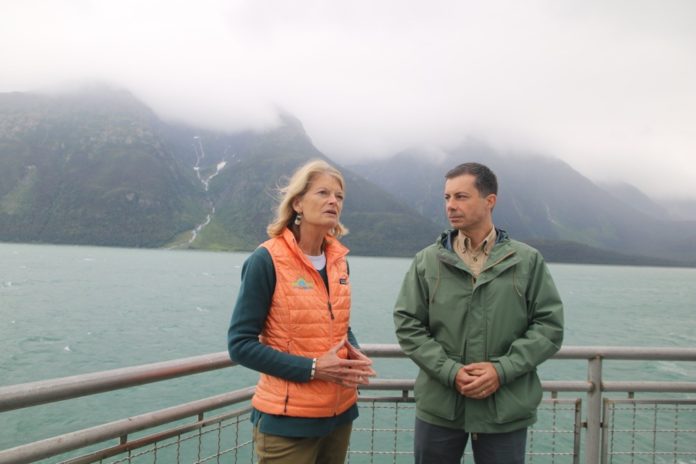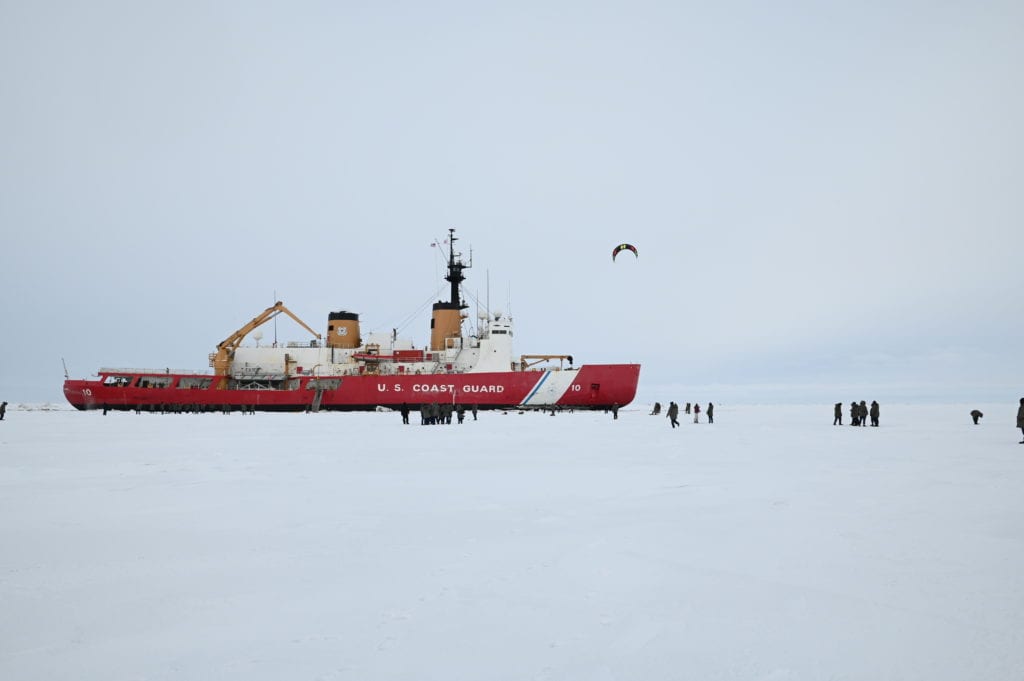
By Sen. Lisa Murkowski, R-Alaska
This piece was originally given as a speech to the Arctic Circle Assembly on Oct. 20, 2023. The Arctic Circle Assembly is the largest annual international gathering on the Arctic.
President Grímsson, colleagues and peers from across the Arctic, and all who are here at the Arctic Circle Assembly, thank you for the opportunity to take this stage and share my perspective on the Far North.
This is the largest Assembly to date. Initially, U.S. participation was pretty sparse. We were a pretty tight group of “Arctic regulars” including folks like Mike Sfraga, David Balton, John Farrell, and me.
This year, I’m proud to be joined by a robust contingent from the U.S. public and private sectors and across Alaska—from Mike and David, who are still with us; to our Assistant Secretary of Energy for International Affairs, Dr. Andrew Light; our Deputy Assistant Secretary of Defense, Iris Ferguson; Coast Guard leadership and the crew of the Healy; and students, researchers, and general Arctic enthusiasts.
I’m encouraged that U.S. interest in the Arctic is so visibly growing. America has finally appreciated that we are an Arctic nation, and our vision for the region is slowly but surely taking shape.
It’s been a struggle to get here. Our vision is still a work-in-progress, far from perfect and missing key components. But I believe we have turned the corner—from talking about getting policy and personnel in place, to mostly having them in place, and being able to shift our focus to implementation and real-world leadership.
I want to talk for just a moment about what we have put in place, before I turn to what comes next.
Despite what you may see reported in the media, Congress has been able to legislate. I’m sure that it seems we lurch from one crisis to the next. You see our federal government come to the brink of default and a potential shutdown. You see the Speaker’s chair vacant. You see the rank partisanship that is paralyzing our politics and polarizing our people.
All of that is true and hard for people like me. But despite it, even in the midst of it, we have been able to agree on major legislation that provides unprecedented support for our Arctic priorities.
As a result of our bipartisan infrastructure law, passed two years ago, we are making historic investments for the basic necessities of modern life, from water and sewer to broadband. This will help ensure our Arctic residents can enjoy a 21st century standard of living, while living in their traditional homelands.
We are doing more to build out sustainable, resilient communities in the face of climate change through both the infrastructure law and the Inflation Reduction Act.
We are building our first deep draft Arctic port at Nome.
We have fully funded two icebreakers, approved appropriations for a third, and are moving closer to acquiring a commercially available vessel.
We now have more fifth-generation fighter jets in Alaska than anywhere else. And, we have enhanced our long-range discrimination radar and missile defense.
From infrastructure to climate resilience to national defense, Congress has stepped up on the Arctic. And our laws are drawing attention, even envy, from our peers.
In most instances, Congress’ attention to the Arctic is being matched by the Biden administration. Here I want to single out last year’s U.S. National Security Strategy, which offered unprecedented priorities and established a whole-of-government focus for the region.
This document has given practical purpose to the Department of Defense’s Arctic-related strategies and efforts, including unilateral defense requirements, bi-national advancements with NORAD, and a new era for the Arctic role and northern leadership of NATO.
Beyond that, DOD’s newest regional center – the Ted Stevens Center for Arctic Security Studies – continues to take root in Anchorage while growing a global network of Arctic partners and activities, including here this week.
The 11th Airborne Division – the first unit in DOD history to have a nationally-designated Arctic mission – leads the U.S. military in pioneering our operational capabilities for the region.
The National Security Strategy also supports our State Department’s role in Arctic diplomacy, foreign affairs, and regional leadership. Hopefully, we will soon have an Alaskan serving as the first U.S. Ambassador for the Arctic-At-Large.
Outside of defense and diplomacy, the Department of Energy published its inaugural Arctic strategy last October. The National Renewable Energy Laboratory has a growing campus in Fairbanks, through our former Cold Climate Housing Research Center. And the reconstituted Arctic Energy Office is living up to its motto—to “bring the Arctic to DOE and DOE to the Arctic”—in areas like microgrids and critical minerals.

Coordinating all of these activities is the revived Arctic Executive Steering Committee, which provides guidance to our federal agencies and departments and just released its implementation strategy for the Arctic on Tuesday. I know you’ve already heard the highlights from Ambassador Balton.
The executive branch of the U.S. government now has a strategy and mission for the U.S. Arctic. While I believe it is remarkably weak with respect to resource development, I support it in most other places. And ultimately, there is no question that nearly across the board, the United States has leveled-up its commitment to the Arctic.
Our challenge now is to move out on this, while filling the remaining gaps and addressing new challenges, to build on the progress we’ve made.
So, here’s what I see next. Phase two, if you will.
Implementation—providing the resources to get our new laws and strategies right.
That’s a significant undertaking, but we need to complement it by advancing our Arctic priorities anywhere we can. The farm bill is a good example: we can use it to prioritize Arctic food security, by expanding its programs to support industries like mariculture and focusing on unique opportunities like reindeer husbandry and herding.
We also need to expedite long-stalled federal actions, like the creation of the Shipping Federal Advisory Committee, which has taken six years and counting, but is an imperative as shipping increases through the Bering Straits.
We need to ratify the Law of the Sea Treaty. While the United States may already abide by it, our lack of approval could cost us valuable territory and resources.
We need to focus free trade in the Arctic, which will boost growth and development in all of our nations. Another aspect is expanded visa eligibility, which we are pushing for with Iceland, in particular, to facilitate visits and business in the U.S.
We will need to address the two elephants in the room—Russia’s absence from it, and China’s presence in it—and the threats each presents to the rules-based order that must prevail in the Arctic.
Both Russia and China raise a new set of risks for the Arctic. One, for Alaska, is the non-Polar Code compliant tankers that Russia is using to ship oil to China and elsewhere, which is simply unacceptable.
I would respectfully suggest to our Chinese counterparts that you have leverage on Moscow, and you could easily put a stop to that troubling trend.
All of us are wary of Russia and China, but I would remind you that seven is greater than two—both in math and in the Arctic. Some suggested the pause for most Arctic Council activities necessitated by Russia’s awful war in Ukraine would be the end of Arctic governance. It’s been anything but, with the Arctic 7 closer than ever, more aligned than ever, Finland joining NATO, and Sweden next in line.
We can also be thankful that the Arctic Parliamentarians, who met this week, have continued our important work together on regional affairs.
I’ve outlined a lot already, but want to close with my top priority, which remains the people of the Arctic.
Later today, I’ll be speaking virtually to the Alaska Federation of Natives, whose convention is underway in Anchorage. Whenever I speak with them, whenever I visit their homes and communities, I’m reminded of the strength that is gained in listening to their knowledge and understanding of the land and its resources.
Their knowledge needs to be reflected in our policies. We’ve started by incorporating Indigenous Ways of Knowing, which increasingly identify, define, and guide whole-of-government responses to Arctic challenges and opportunities. There is significant value to that, but it’s only the beginning.
In rural Alaska, we face tremendous challenges related to subsistence, housing, the cost of living, and the impacts of climate change.
Wildfires are growing worse. Stronger storms, like Typhoon Merbok, are damaging our coasts. Invasive species are arriving. Permafrost is melting, sea ice is receding, and entire communities are threatened.
We also have a crisis of outmigration from our remote communities, where we can’t reasonably expect young people to stay if they don’t feel connected to the world.
These are some of the most pressing questions facing the Arctic: how do we build the infrastructure we need? How do we prepare for an uncertain future? How do we keep young people around?
The U.S. answer has started with major legislation that will help connect the Arctic to the rest of the world—modern living connected by fast internet, flights out, ways back in and reasons to stick around. But ultimately, this is going to be an area where our Arctic partnership really matters.
I recognize that the U.S. was the last to step up in the Far North. Know that our commitment will endure. Our laws are solid, our strategies are meaningful, we are serious about them, and their implementation is underway.
The U.S. has a lot to be proud of, but the final piece of our strategy is recognizing that we aren’t “America, alone.” We have strong partners across the Arctic, with many of the same opportunities we have, and facing many of the same challenges we face.
So, for as much as we have put in place, international cooperation is at the center of America’s new vision for the Arctic. We must insist – as the Arctic nations – that others who wish to be part of our Arctic affairs do so under our collective terms.
As I look around this room, I’m grateful to see so many partners ready to keep the Arctic stable, secure, and thriving—a place on the planet that can, with hard work and leadership and cooperation, remain exceptional.














